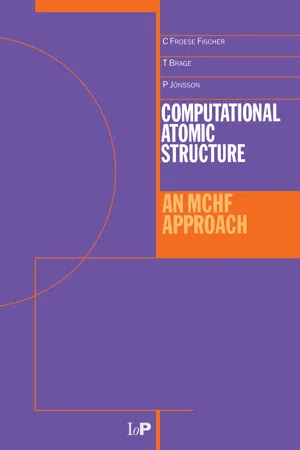
- 244 pages
- English
- ePUB (mobile friendly)
- Available on iOS & Android
eBook - ePub
About this book
Computational Atomic Structure: An MCHF Approach deals with the field of computational atomic structure, specifically with the multiconfiguration Hartree-Fock (MCHF) approach and the manner in which this approach is used in modern physics. Beginning with an introduction to computational algorithms and procedures for atomic physics, the book describes the theory underlying nonrelativistic atomic structure calculations (making use of Brett-Pauli corrections for relativistic effects) and details how the MCHF atomic structure software package can be used to this end. The book concludes with a treatment of atomic properties, such as energy levels, electron affinities, transition probabilities, specific mass shift, fine structure, hyperfine-structure, and autoionization. This modern, reliable exposition of atomic structure theory proves invaluable to anyone looking to make use of the authors' MCHF atomic structure software package, which is available publicly via the Internet.
Frequently asked questions
Yes, you can cancel anytime from the Subscription tab in your account settings on the Perlego website. Your subscription will stay active until the end of your current billing period. Learn how to cancel your subscription.
At the moment all of our mobile-responsive ePub books are available to download via the app. Most of our PDFs are also available to download and we're working on making the final remaining ones downloadable now. Learn more here.
Perlego offers two plans: Essential and Complete
- Essential is ideal for learners and professionals who enjoy exploring a wide range of subjects. Access the Essential Library with 800,000+ trusted titles and best-sellers across business, personal growth, and the humanities. Includes unlimited reading time and Standard Read Aloud voice.
- Complete: Perfect for advanced learners and researchers needing full, unrestricted access. Unlock 1.4M+ books across hundreds of subjects, including academic and specialized titles. The Complete Plan also includes advanced features like Premium Read Aloud and Research Assistant.
We are an online textbook subscription service, where you can get access to an entire online library for less than the price of a single book per month. With over 1 million books across 1000+ topics, we’ve got you covered! Learn more here.
Look out for the read-aloud symbol on your next book to see if you can listen to it. The read-aloud tool reads text aloud for you, highlighting the text as it is being read. You can pause it, speed it up and slow it down. Learn more here.
Yes! You can use the Perlego app on both iOS or Android devices to read anytime, anywhere — even offline. Perfect for commutes or when you’re on the go.
Please note we cannot support devices running on iOS 13 and Android 7 or earlier. Learn more about using the app.
Please note we cannot support devices running on iOS 13 and Android 7 or earlier. Learn more about using the app.
Yes, you can access Computational Atomic Structure by Charlotte Froese-Fischer in PDF and/or ePUB format, as well as other popular books in Physical Sciences & Atomic & Molecular Physics. We have over one million books available in our catalogue for you to explore.
Information
Topic
Physical SciencesSubtopic
Atomic & Molecular PhysicsChapter 1
Introduction
1.1 Introduction
According to quantum mechanics (Messiah 1965) a stationary state of an N- electron atom is described by a wave function , where represents the space and spin co-ordinates† of the electron labelled . The wave function is assumed to be continuous with respect to the space variables and is a solution to the wave equation
(1.1)
where is the Hamiltonian operator for the atomic system. The wave equation is an eigenvalue problem, and solutions exist only for certain values of These values are known as the eigenvalues of the operator, and they represent the possible values of the total energy of the system. Following the mathematical terminology, the set of all eigenvalues is known as the eigenvalue spectrum of the operator.
The operator depends on the atomic system as well as on the underlying quantum mechanical form alism. For non-relativistic calculations, the norm al starting point is Schrödinger’s equation where the Hamiltonian, in atomic units (see appendix C) is given as
(1.2)
Here is the nuclear charge of the atom, is the distance of electron from the nucleus and is the distance between electron and electron . The above Hamiltonian is valid under the a...
Table of contents
- Cover
- Half Title
- Title Page
- Copyright Page
- Table of Contents
- Preface
- Acknowledgments
- 1 Introduction
- 2 Configuration State Functions and Hamiltonian
- 3 Hartree–Fock Calculations
- 4 Multiconfiguration Hartree–Fock Wave Functions
- 5 Two-Electron Systems
- 6 Correlation in Many-Electron Systems
- 7 Relativistic Effects
- 8 Isotope and Hyperfine Effects
- 9 Allowed and Forbidden Transitions
- 10 MCHF Continuum Wave Functions
- Appendices
- References
- Index